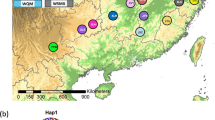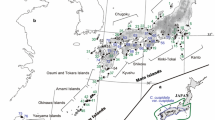Abstract
Phyllanthus amarus and Phyllanthus fraternus are important ethnomedicinal herbs used as traditional medicines in many parts of the world. The increasing popularity of these green medicines and almost no studies on structuring of genetic diversity in these herbs, led to this investigation. Keeping this in view, our main objective was to analyze the structuring of chloroplast DNA diversity in wild populations of the two herbs from Northern India, using chloroplast DNA (cpDNA) markers. PCR–RFLP of cpDNA regions was carried out to detect intraspecific polymorphisms. The study revealed differences in cpDNA diversity in the two ethnomedicinal herbs. Lower cpDNA diversity, lesser number of haplotypes and absence of correlation between phylogeny and geographical distribution of haplotypes were observed in P. amarus. Absence of phylogeographic structure in P. amarus may be attributed partly to higher anthropogenic intervention, owing to its commercialization for export and raw drug trade. The investigation identified populations with high haplotype diversity and unique haplotypes in both the herbs, which will be useful while formulating future conservation strategies. As there are comparatively less number of studies on structure of cpDNA diversity in annuals, the present analyses also add to the available data on population genetic structure in annual plants.





Similar content being viewed by others
References
Adeneye AA, Benebo AS (2008) Protective effect of the aqueous leaf and seed extract of Phyllanthus amarus on gentamicin and acetaminophen-induced nephrotoxic rats. J Ethnopharmacol 118:318–323
Austerlitz F, Mariette S, Machon N, Gouyon PH, Godelle B (2000) Effects of colonization processes on genetic diversity: differences between annual plants and tree species. Genetics 154:1309–1321
Birky CW (1995) Uniparental inheritance of mitochondrial and chloroplast genes: mechanisms and evolution. Proc Natl Acad Sci USA 92:11331–11338
Burban C, Petit RJ, Carcreff E, Jactel H (1999) Rangewide variation of the maritime pine bast scale Matsucoccusfeytaudi Duc. (Homoptera: Matsucoccidae) in relation to the genetic structure of its host. Mol Ecol 8:1593–1602
Calixto JB, Santos ARS, Filho VC, Yunes RA (1998) A review of the plants of the Genus Phyllanthus: their chemistry, pharmacology and therapeutic potential. Med Res Rev 18:225–258
Chaudhary IB, Rao RR (2002) Taxonomic study of herbaceous species of Phyllanthus L. (Euphorbiaceae) in India. Phytotaxonomy 2:143–162
Dumolin-Lapegue S, Pemonge MH, Petit RJ (1997) An enlarged set of consensus primers for the study of organelle DNA in plants. Mol Ecol 6:393–397
Gamble JS, Dunn ST (1915) Flora of the Presidency of Madras
Garg M, Dhar VJ, Kalia AN (2008) Antidiabetic and antioxidant potential of Phyllanthus fraternus in alloxan induced diabetic animals. Pharmacogn Mag 4:138
Gopi S, Setty OH (2010) Protective effect of Phyllanthus fraternus against bromobenzene induced mitochondrial dysfunction in rat liver mitochondria. Food Chem Toxicol 48:2170–2175
Gupta AK, Khanuja SPS, Gupta MM et al (2003) High phyllanthin and hypophyllanthin yielding variety of Bhumyamalaki (Phyllanthus amarus): CIM-Jeevan. J Med Arom Plant Sci 25:743–745
Jain N, Shasany AK, Sundaresan V et al (2003) Molecular diversity in Phyllanthus amarus assessed through RAPD analysis. Curr Sc 85:1454–1458
Kala CP, Dhyani PP, Sajwan BS (2006) Developing the medicinal plants sector in Northern India: challenges and opportunities. J Ethnobiol Ethnomed 2:1–15
Kamble MB, Dumbre RK, Rangari VD (2008) Hepatoprotective activity studies of herbal formulations. Int J Green Pharm 2:147
Kato M, Kosaka Y, Kawakita A, Okuyama Y, Kobayashi C, Phimminith T, Thongphan D (2008) Plant–pollinator interactions in tropical monsoon forests in Southeast Asia. Am J Bot 95:1375–1394
Kuppusamy C, Murugan K (2010) In vitro antimalarial activity of traditionally used Western Ghats plants from India and their interactions with chloroquine against chloroquine resistant Plasmodium falciparum. Parasitol Res 107:1351–1364
Lalithamba A (2011) Identification manual for some species of the genus Phyllanthus L. of Phyllanthaceae with special reference to Indian subcontinent. In: Kuttan RR, Harikumar KB (eds) Phyllanthus species: scientific evaluation and medicinal applications. CRC Press, Boca Raton, pp 23–36
Machado CA, de Oliveira PL, Mentz LA (2006) SEM observation on seeds of some herbaceous Phyllanthus L. species (Phyllanthaceae). Rev Bras Farmacogn 16:31–41
Maheswari JK (1963) The flora of Delhi. Council for Scientific and Industrial Research Publication, New Delhi
Mahishi P, Srinivasa BH, Shivanna MB (2005) Medicinal plant wealth of local communities in some villages in Shimoga District of Karnataka, India. J Ethnopharmacol 98:307–312
Palaniappan M, Marappa M (2006) RAPD and ISSR analyses reveal low levels of genetic diversity in Phyllanthus amarus. In: XXVII international horticultural congress-IHC 2006: international symposium on plants as food and medicine: the utilization. ISHS Acta Horticulture 765:179–188
Palmer JD (1985) Comparative organization of chloroplast genomes. Annu Rev Genet 19:325–354
Patel JR, Tripathi P, Sharma V, Chauhan NS, Dixit VK (2011) Phyllanthus amarus: ethnomedicinal uses, phytochemistry and pharmacology. J Ethnopharmacol 138:286–313
Petit RJ, Kremer A, Wagner DB (1993) Finite island model for organelle and nuclear genes in plants. Heredity 71:630–641
Petit RJ, Csaikl UM, Bordács S et al (2002) Chloroplast DNA variation in European white oaks: phylogeography and patterns of diversity based on data from over 2,600 populations. For Ecol Manage 156:5–26
Petit RJ, Duminil J, Fineschi S, Hampe A, Salvini D, Vendramin GG (2005) Comparative organization of chloroplast, mitochondrial and nuclear diversity in plant populations. Mol Ecol 14:689–701
Pons O, Petit RJ (1996) Measuring and testing genetic differentiation with ordered versus unordered alleles. Genetics 144:1237–1245
Prim RC (1957) Shortest connection networks and some generalizations. Bell Labs Techn J 36:1389–1401
Rao BRR (2011) Cultivation, economics and marketing of Phyllanthus species. In: Kuttan RR, Harikumar KB (eds) Phyllanthus species: scientific evaluation and medicinal applications. CRC Press, Boca Raton, pp 47–70
Ravikanth G, Srirama R, Senthilkumar U, Ganeshaiah KN, Uma Shaankar R (2011) Genetic resources of Phyllanthus in Southern India: identification of geographic hotspots and its implication for conservation. In: Kuttan RR, Harikumar KB (eds) Phyllanthus species: scientific evaluation and medicinal applications. CRC Press, Boca Raton, pp 97–118
Rohlf FJ (2008) NTSYSpc: numerical taxonomy system, ver. 2.20. Exeter Publishing, Ltd, Setauket
Samuel JK, Andrews B (2010) Traditional medicinal plant wealth of Pachalur and Periyur hamlets Dindigul District, Tamil Nadu. Ind J Tradit Knowl 9:264–270
Samy RP, Pushparaj PN, Gopikrishnakone PA (2008) Compilation of bioactive compounds from Ayurveda. Bioinformation 3:100–110
Sarin B, Mohanty A, Clemente JPM (2013) PCR–RFLP to distinguish three Phyllanthus sp, commonly used in herbal medicines. S Afr J Bot 88:455–458
Sarin B, Verma N, Clemente JPM, Mohanty A (2014) An overview of important ethnomedicinal herbs of Phyllanthus species: present status and future prospects. World Scient J (in press)
Sharma I, Sharma N, Kour H (2009) Studies on the role of ants in reproductive efficiency of three species of Phyllanthus L. Curr Sci 96:283–287
Sittie AA, Lemmich E, Olsen CE, Hviid L, Brogger SC (1998) Alkamides from Phyllanthus fraternus. Planta Med 64:192–193
Srirama R, Senthilkumar U, Sreejayan N et al (2010) Assessing species admixtures in raw drug trade of Phyllanthus, a hepatoprotective plant using molecular tools. J Ethnopharmacol 130:208–215
Torres AM, Weeden NM, Martin A (1993) Linkage among isozyme, RFLP and RAPD markers in Viciafaba. Theor Appl Genet 85:937–945
Webster GL (1957) A monographic study of West Indian species of Phyllanthus. J Arnold Arboretum 38(51–80):295–373
Acknowledgments
This work was supported by Department of Science and Technology and Department of Biotechnology, Government of India. We gratefully acknowledge the help provided by Central Instrumentation Facility, South Campus, University of Delhi.
Author information
Authors and Affiliations
Corresponding author
Electronic supplementary material
Below is the link to the electronic supplementary material.
Rights and permissions
About this article
Cite this article
Sarin, B., Martín, J.P. & Mohanty, A. Differences in population genetic structure of two ethnomedicinal herbs of the genus Phyllanthus from India: a consequence of anthropogenic intervention?. Plant Syst Evol 301, 667–676 (2015). https://doi.org/10.1007/s00606-014-1104-y
Received:
Accepted:
Published:
Issue Date:
DOI: https://doi.org/10.1007/s00606-014-1104-y




